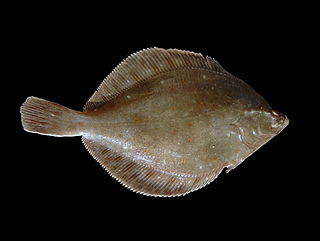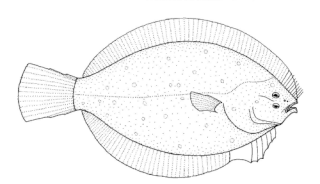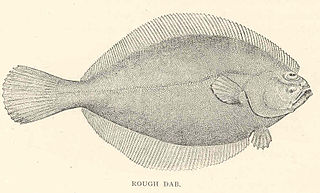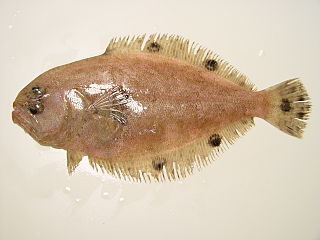
A flatfish is a member of the ray-finned demersal fish order Pleuronectiformes, also called the Heterosomata, sometimes classified as a suborder of Perciformes. In many species, both eyes lie on one side of the head, one or the other migrating through or around the head during development. Some species face their left sides upward, some face their right sides upward, and others face either side upward.

Citharichthys is a genus of flatfish in the large-tooth flounder family, Paralichthyidae. They have both eyes on the left sides of their heads. They are native to the oceans around the Americas, with a single species, C. stampflii off the West African coast. Most are found in relatively shallow depths, but the genus also includes species found in deep water and species that enter fresh water.

Pleuronectidae, also known as righteye flounders, are a family of flounders. They are called "righteye flounders" because most species lie on the sea bottom on their left sides, with both eyes on their right sides. The Paralichthyidae are the opposite, with their eyes on the left side. A small number of species in Pleuronectidae can also have their eyes on the left side, notably the members of the genus Platichthys.

Pleuronectes is a genus of righteye flounders found in the northern oceans.

Rhombosolea is a genus of righteye flounders. The four species in this genus can be found in the waters around New Zealand and southern Australia.

Limanda is a genus of righteye flounders native to the northern Atlantic and Pacific oceans.

Liopsetta is a genus of righteye flounders native to the northern oceans.

Atheresthes is a genus of righteye flounders native to the north Pacific Ocean where both species are important commercially.

Hippoglossoides is a genus of righteye flounders native to the North Pacific and North Atlantic oceans.

Pseudopleuronectes is a genus of righteye flounders mostly native to the northwestern Pacific Ocean with one species found in the northwestern Atlantic Ocean.

The Citharidae or largescale flounders are a small family of flounders with four genera. Three genera are restricted to the Indo-Pacific, while Citharus is from the Mediterranean and East Atlantic. There are a total of seven species. Species reach lengths ranging between 14 and 36 centimetres.

Bothus is a genus of flatfish in the family Bothidae from the Pacific, Indian and Atlantic Oceans. Some species in this genus have spots consisting of blue rings.

The scaldfishes comprise a genus, Arnoglossus, of lefteye flounders. They are found in the Pacific, Indian and Atlantic Oceans, including the Mediterranean and Black Sea. They are entirely absent from most of the Americas; the only exceptions are A. coeruleosticta and A. multirastris found off Chile. The genus include both species found in shallow and deeper water. The largest species reaches 28 cm (11 in).
Perissias taeniopterus, the striped-fin flounder, is a species of lefteye flounder native to the eastern Pacific Ocean along the coast of Central America from Mexico to Panama. It is found at depths of from 46 to 157 metres. This species grows to a length of 11 centimetres (4.3 in) TL. This species is the only known member of its genus.

Ancylopsetta is a genus of large-tooth flounders mostly found along the Atlantic coast of the Americas with one species found along the Pacific coast.

Cyclopsetta is a genus of large-tooth flounders native to the coastal waters of the Americas.

Etropus is a genus of large-tooth flounders native to the coastal waters of the Americas.

Paralichthys is a genus of large-tooth flounders. Most species are native to the coastal waters of the Americas, but P. olivaceus is from northeast Asia. The largest species reaches about 1.5 m (5 ft) in length.

Syacium is a genus of large-tooth flounders found in the Atlantic and Pacific Oceans. With the exception of S. guineensis from the Atlantic coast of Africa, all species are from the Americas. The largest species in the genus reaches 40 cm (16 in) in length.
Xystreurys is a genus of large-tooth flounders with one species, X. liolepis, found along the Pacific coast of North America from Monterey Bay, California to the Gulf of California and the other, X. rasile, found along the Atlantic coast of South America from Rio de Janeiro, Brazil to the southern tip of Argentina.
















